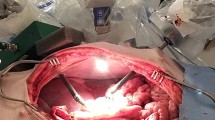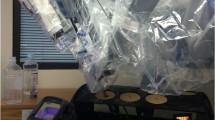Abstract
Introduction
Stray energy from surgical energy instruments can cause unintended thermal injuries. There are no published data regarding electrosurgical generators and their influence on stray energy transfer during robotic surgery. There are two approved generators for the DaVinci Xi robotic platform: a constant-voltage regulating generator (cVRG) and a constant-power regulating generator (cPRG). The purpose of this study was to quantify and compare stray energy transfer in the robotic Xi platform using a cVRG versus a cPRG.
Methods
An ex vivo bovine model was used to simulate a standard multiport robotic surgery. The DaVinci Xi (Intuitive Surgical, Sunnyvale, CA) robotic platform was attached to a trainer box using robotic ports. A 5 s, open-air activation of the monopolar scissors was done with commonly used electrosurgical settings using a cPRG (ForceTriad, Covidien-Medtronic, Boulder, CO) or cVRG (ERBE VIO 300 dV 2.0, ERBE USA, Marietta, GA). Stray energy transfer was quantified as the change in tissue temperature (°C) nearest the tip of the assistance grasper (which was not in direct contact with the active monopolar scissors).
Results
Stray energy transfer occurred with both generators. Utilizing common, comparable settings for standard coagulation, significantly less stray energy was transferred with the cVRG versus cPRG (4.4 ± 1.6 °C vs. 41.1 ± 13.0 °C, p < 0.001). Similarly, less stray energy was transferred using cut modes with the cVRG compared to the cPRG (5.61 ± 1.79 °C vs. 33.9 ± 18.4 °C, p < 0.001).
Conclusion
Stray energy transfer increases tissue temperatures more than 45C in the DaVinci Xi robotic platform. Low voltage modalities, such as cut or blend; as well as a cVRG generator, significantly reduces stray energy. Robotic surgeons can minimize the risk of stray energy injuries by using these low risk modes and/or generator.
Similar content being viewed by others
References
Willson PD, Mcanena OJ, Peters EE (1994) A fatal complication of diathermy in laparoscopic surgery. Minim Invasive Ther Allied Technol. https://doi.org/10.3109/13645709409152989
Federer B (2006) Surgical device poses a rare but serious peril. New York Times
Guzman C, Forrester JA, Fuchshuber PR, Eakin JL (2019) Estimating the incidence of stray energy burns during laparoscopic surgery based on two statewide databases and retrospective rates: an opportunity to improve patient safety. Surg Technol Int 34:30–34
Jones EL, Madani A, Overbey DM et al (2017) Stray energy transfer during endoscopy. Surg Endosc. https://doi.org/10.1007/s00464-017-5427-y
Overbey DM et al (2015) Surgical energy-based device injuries and fatalities reported to the Food and Drug Administration. J Am Coll Surg 221(1):197-205e1
Townsend NT, Jones EL, Overbey D, Dunne B, McHenry J, Robinson TN (2017) Single-incision laparoscopic surgery increases the risk of unintentional thermal injury from the monopolar “Bovie” instrument in comparison with traditional laparoscopy. Surg Endosc 31(8):3146–3151
Friedman DC, Lendvay TS, Hannaford B (2013) Instrument failures for the da Vinci Surgical System: a Food and Drug Administration MAUDE database study. Surg Endosc 27(5):1503–1508
Fieber JH, Kuo LE, Wirtalla C, Kelz RR (2019) Variation in the utilization of robotic surgical operations. J Robot Surg 14(4):593–599
Stewart CL, Dumitra S, Nota C, Ituarte P, Melstrom LG, Woo Y, Singh G, Fong Y, Nathan H, Warner SG (2019) Hospital factors strongly influence robotic use in general surgery. Surgery 166(5):867–872
Mendez-Probst CE et al (2011) Stray electrical currents in laparoscopic instruments used in da Vinci ® robot-assisted surgery: an in vitro study. J Endourol 25(9):1513–1517
Wikiel KJ, Overbey DM, Carmichael H, Chapman DC, Moore JT, Barnett CC, Jones TS, Robinson TN, Jones EL (2021) Stray energy transfer in single incision robotic surgery. Surg Endosc 35(6):2981–2985
Overbey DM, Carmichael H, Wikiel KJ, Hirth DA, Chapman DC, Moore JT, Barnett CC, Jones TS, Robinson TN, Jones EL (2021) Monopolar stray energy in robotic surgery. Surg Endosc 35(5):2084–2090
Wikiel KJ, Robinson TN, Jones EL (2021) Energy in robotic surgery. Ann Laparosc Endosc Surg. https://doi.org/10.21037/ales.2020.03.06
The R Foundation—R: the R project for statistical computing. https://www.r-project.org/foundation. Accessed 22 Sept 2021
Feldman LS, Fuchshuber P, Jones DB, Mischna J, Schwaitzberg SD (2012) Surgeons don’t know what they don’t know about the safe use of energy in surgery. Surg Endosc 26(10):2735–2739. https://doi.org/10.1007/s00464-012-2263-y
Tuncel U, Ozgenel GY (2005) Thermal injury due to electrosurgery. Ulus Travma Acil Cerrahi Derg 11(1):76–77
Sankaranarayanan G et al (2013) Common uses and cited complications of energy in surgery. Surg Endosc 27(9):3056–3072
Martin KE et al (2016) Quantifying inadvertent thermal bowel injury from the monopolar instrument. Surg Endosc 30(11):4776–4784
Cassaro S (2015) Delayed manifestations of laparoscopic bowel injury. Am Surg 81(5):478–482
Jones EL, Mikami DJ (2018) Ch 19—surgical energy. In: Fischer JE (ed) Fischer’s mastery of surgery, 7th edn. Wolters Kluwer Lippincott Williams & Wilkins, Philadelphia, pp 273–282
Fuller A et al (2012) Electrosurgical injuries during robot-assisted surgery: insights from the FDA MAUDE database. Proc. Of SPIE 820714-1
Montero PN et al (2010) Insulation failure in laparoscopic instruments. Surg Endosc 24(2):462–465
Voyles CR, Tucker RD (1992) Education and engineering solutions for potential problems with laparoscopic monopolar electrosurgery. Am J Surg 164(1):57–62
Robinson TN et al (2010) Surgeon-controlled factors that reduce monopolar electrosurgery capacitive coupling during laparoscopy. Surg Laparosc Endosc Percutaneous Tech 20(5):317–320
Robinson TN et al (2015) Separating the laparoscopic camera cord from the monopolar “Bovie” cord reduces unintended thermal injury from antenna coupling: a randomized controlled trial. Ann Surg 261(6):1056–1060. https://doi.org/10.1097/SLA.0000000000000841
Karacan T, Usta T, Ozkaynak A, OnurCakir O, Kahraman A, Ozyurek E (2018) Comparison of the thermal spread of three different electrosurgical generators on rat uterus: a preliminary experimental study. Gynecol Obstet Investig 83(4):388–396
Yarmolenko PS, Moon EJ, Landon C, Manzoor A, Hochman DW, Viglianti BL, Dewhirst MW (2011) Thresholds for thermal damage to normal tissues: an update. Int J Hyperth 27(4):320–343
Jones EL, Dunn CL, Townsend NT, Jones TS, Dunne JB, Montero PN, Govekar HR, Stiegmann GV, Robinson TN (2013) Blend mode reduces unintended thermal injury by laparoscopic monopolar instruments: a randomized controlled trial. Surg Endosc 27(11):4016–4020
Erbe, Vio 300 D. Technical data manual. https://us.erbe-med.com/us-en/products/electrosurgery/vio-300-d/. Accessed 22 Sept 2021
Covidien ForceTriad User Manual. https://www.manualslib.com/manual/1605183/Covidien-Forcetriad.html. Accessed 22 Sept 2021
Author information
Authors and Affiliations
Corresponding author
Ethics declarations
Disclosures
Krzysztof J. Wikiel has received travel reimbursement from Intuitive Surgical, Inc. to participate in resident training labs in Sunnyvale, CA and Houston, TX. Edward L. Jones is a consultant for Boston Scientific. Teresa S. Jones, Franklin J. Powlan, and Thomas N. Robinson have no conflicts of interest or financial ties to disclose.
Additional information
Publisher's Note
Springer Nature remains neutral with regard to jurisdictional claims in published maps and institutional affiliations.
This study was be presented at the 2021 SAGES Annual Meeting in Las Vegas, NV.
Rights and permissions
About this article
Cite this article
Wikiel, K.J., Powlan, F.J., Jones, T.S. et al. Robotic stray energy with constant-voltage versus constant-power regulating electrosurgical generators. Surg Endosc 37, 580–586 (2023). https://doi.org/10.1007/s00464-022-09316-5
Received:
Accepted:
Published:
Issue Date:
DOI: https://doi.org/10.1007/s00464-022-09316-5








